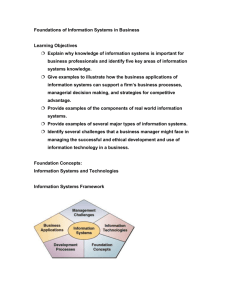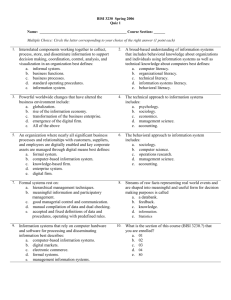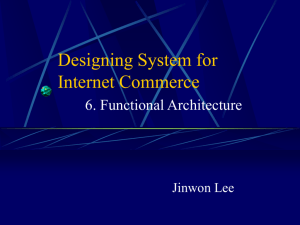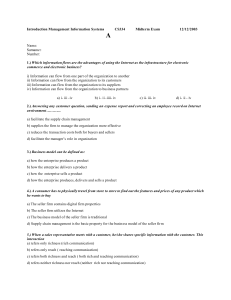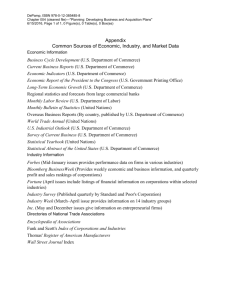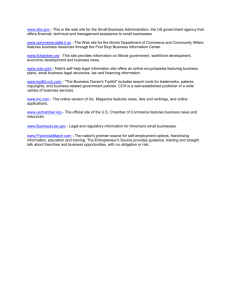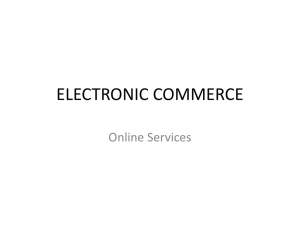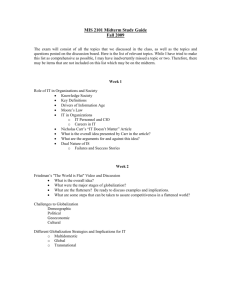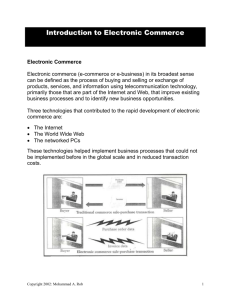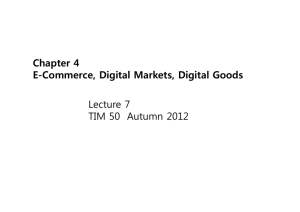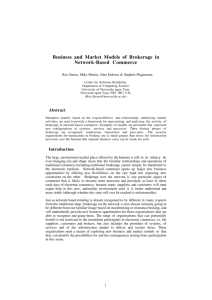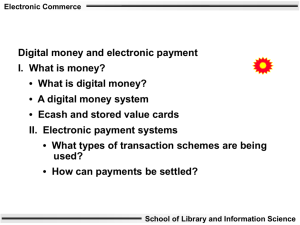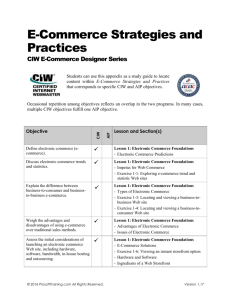Solution
advertisement
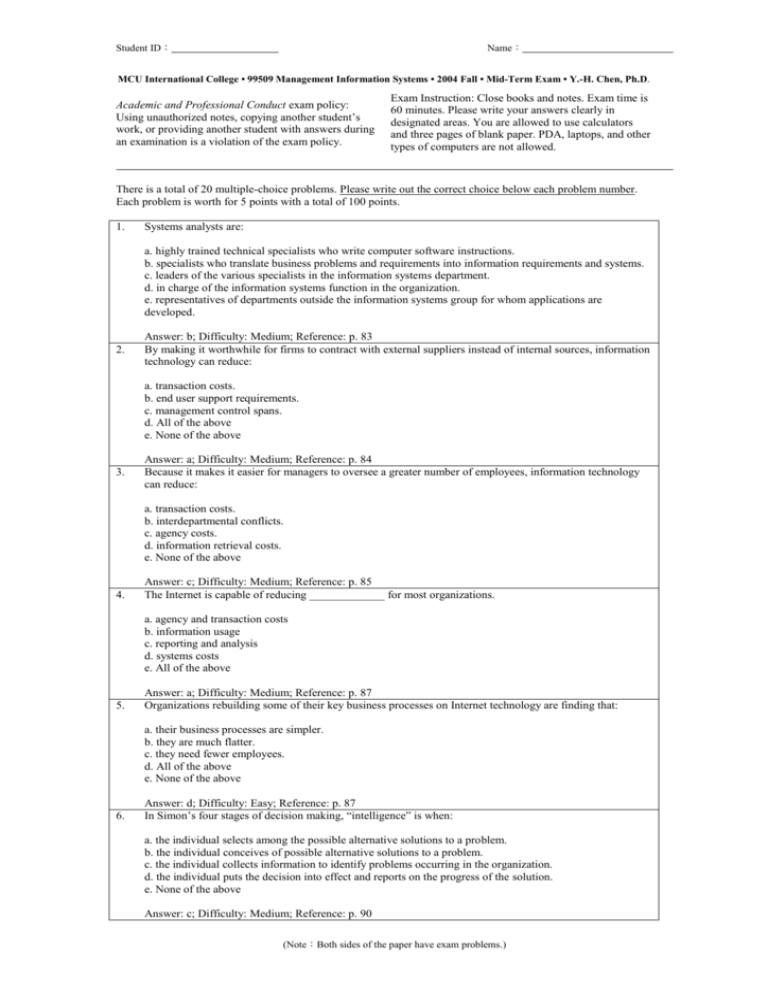
Student ID: Name: MCU International College • 99509 Management Information Systems • 2004 Fall • Mid-Term Exam • Y.-H. Chen, Ph.D. Academic and Professional Conduct exam policy: Using unauthorized notes, copying another student’s work, or providing another student with answers during an examination is a violation of the exam policy. Exam Instruction: Close books and notes. Exam time is 60 minutes. Please write your answers clearly in designated areas. You are allowed to use calculators and three pages of blank paper. PDA, laptops, and other types of computers are not allowed. There is a total of 20 multiple-choice problems. Please write out the correct choice below each problem number. Each problem is worth for 5 points with a total of 100 points. 1. Systems analysts are: a. highly trained technical specialists who write computer software instructions. b. specialists who translate business problems and requirements into information requirements and systems. c. leaders of the various specialists in the information systems department. d. in charge of the information systems function in the organization. e. representatives of departments outside the information systems group for whom applications are developed. 2. Answer: b; Difficulty: Medium; Reference: p. 83 By making it worthwhile for firms to contract with external suppliers instead of internal sources, information technology can reduce: a. transaction costs. b. end user support requirements. c. management control spans. d. All of the above e. None of the above 3. Answer: a; Difficulty: Medium; Reference: p. 84 Because it makes it easier for managers to oversee a greater number of employees, information technology can reduce: a. transaction costs. b. interdepartmental conflicts. c. agency costs. d. information retrieval costs. e. None of the above 4. Answer: c; Difficulty: Medium; Reference: p. 85 The Internet is capable of reducing _____________ for most organizations. a. agency and transaction costs b. information usage c. reporting and analysis d. systems costs e. All of the above 5. Answer: a; Difficulty: Medium; Reference: p. 87 Organizations rebuilding some of their key business processes on Internet technology are finding that: a. their business processes are simpler. b. they are much flatter. c. they need fewer employees. d. All of the above e. None of the above 6. Answer: d; Difficulty: Easy; Reference: p. 87 In Simon’s four stages of decision making, “intelligence” is when: a. the individual selects among the possible alternative solutions to a problem. b. the individual conceives of possible alternative solutions to a problem. c. the individual collects information to identify problems occurring in the organization. d. the individual puts the decision into effect and reports on the progress of the solution. e. None of the above Answer: c; Difficulty: Medium; Reference: p. 90 (Note:Both sides of the paper have exam problems.) Student ID: 7. A value chain’s primary activities include: a. human resources. b. inbound logistics. c. technology. d. procurement. e. administration and management. 8. Answer: b; Difficulty: Medium; Reference: p. 95 A competitive strategy for creating brand loyalty by developing new and unique products and services that are not easily duplicated by competitors best describes: a. focused differentiation. b. low-cost producer. c. product differentiation. d. quality differentiation. e. marketing differentiation. 9. Answer: c; Difficulty: Medium; Reference: p. 98 Supply chain management can be used to create: a. networked markets. b. efficient customer response systems. c. franchise-based environments. d. wide-ranging data reports. e. demographic-oriented sales. 10. Answer: b; Difficulty: Easy; Reference: p. 100 A customer-driven network of independent firms who use information technology to coordinate their value chains to collectively produce a product or service for a market best describes: a. value Web. b. value chain. c. value extranet. d. value intranet. e. enterprise system. 11. Answer: a; Difficulty: Medium; Reference: p. 97 Electronic retailing of products and services directly to individual consumers best describes: a. business-to-business electronic commerce. b. consumer-to-consumer electronic commerce. c. mobile commerce. d. business-to-consumer electronic commerce. e. consumer networking. 12. Answer: d; Difficulty: Medium; Reference: p. 122 The removal of organizations or business process layers responsible for certain intermediary steps in a value chain is called: a. disintermediation. b. reintermediation. c. customer self-service. d. pure-play. e. dynamic provision. 13. Answer: a; Difficulty: Medium; Reference: p. 123 The shifting of the intermediary role in a value chain to a new source is called: a. disintermediation. b. reentrance. c. reintermediation. d. intermediary relocation. e. distributor displacement. 14. Answer: c; Difficulty: Medium; Reference: p. 124 A system that enables users to make micropayments and purchases on the Web by accumulating a debit balance on their credit card or telephone bill best describes: (Note:Both sides of the paper have exam problems.) 2 of 3 Student ID: a. smart card. b. accumulated balance digital payment system. c. accumulated deferral system. d. digital cash. e. peer-to-peer payment system. 15. Answer: b; Difficulty: Medium; Reference: p. 131 Competition between two or more different distribution chains used to sell the products or services of the same company best describes: a. channel conflict. b. marketing conflict. c. distribution conflict. d. supply chain conflict. e. customer conflict. 16. Answer: a; Difficulty: Medium; Reference: p. 139 A content provider: a. provides product, pricing, and availability information to individuals and businesses. b. provides initial point of entry to the Web and specialized content and other services. c. provides online service for individuals and businesses. d. creates revenue by providing digital content over the Web. e. All of the above 17. Answer: d; Difficulty: Medium; Reference: p. 120 Which of the following Internet business models provides a digital environment where buyers and sellers can meet, search for products, display products, and establish prices for those products? a. Portal b. Virtual community c. Online marketplace d. Transaction broker e. Online service provider 18. Answer: c; Difficulty: Medium; Reference: p. 120 Which of the following Internet business models does Amazon.com use? a. Information broker b. Transaction broker c. Online service provider d. Virtual storefront e. Virtual community 19. Answer: d; Difficulty: Medium; Reference: p. 120 Which of the following is an ad that opens automatically and does not disappear until the user clicks on it? a. Banner ad b. Controlled ad c. Controlled display d. Portal e. Pop-up ad 20. Answer: e; Difficulty: Medium; Reference: p. 121 eBay is an example of: a. a click-and-mortar business. b. consumer-to-consumer electronic commerce. c. business-to-consumer electronic commerce. d. an online community. e. online syndication. Answer: b; Difficulty: Easy; Reference: p. 122 (Note:Both sides of the paper have exam problems.) 3 of 3
